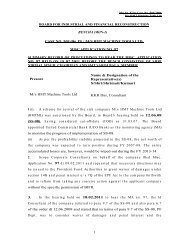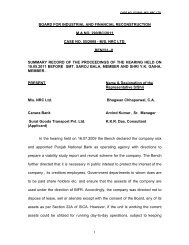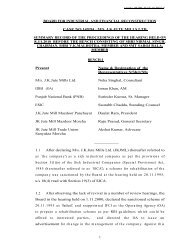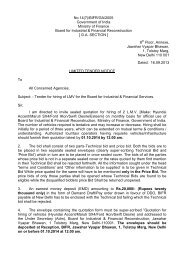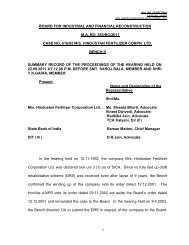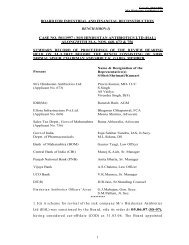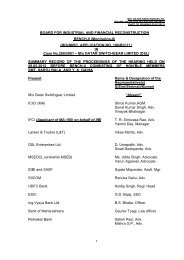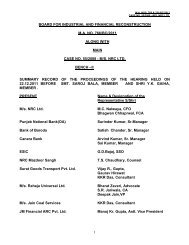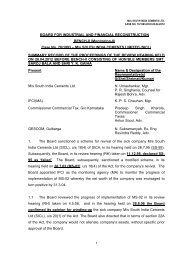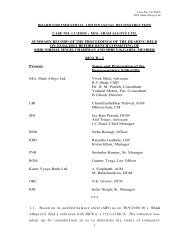BOARD FOR INDUSTRIAL AND FINANCIAL RECONSTRUCTION
BOARD FOR INDUSTRIAL AND FINANCIAL RECONSTRUCTION
BOARD FOR INDUSTRIAL AND FINANCIAL RECONSTRUCTION
Create successful ePaper yourself
Turn your PDF publications into a flip-book with our unique Google optimized e-Paper software.
Case No.70/2006 Duncans Industries Ltd. (DIL)<br />
7.2 Inadequate working capital:<br />
i. In accordance with the CDR Package approved by the CDR Empowered<br />
Committee vide its letter dated 15 th October 2004, the Banks were to<br />
provide Rs 62 Cr of additional Working Capital facility for recommencement<br />
of the operation at the fertilizer plant against an additional exclusive security<br />
of 2.89 Cr equity shares of M/s Andhra Cements Ltd (ACL) held by M/s<br />
Boydell Media Pvt Ltd, a company of Duncan Goenka Group, to be pledged<br />
in favour of Banks. The banks sanctioned additional working capital facility<br />
of Rs 56.45 Cr while the balance Rs 5.55 Cr (State Bank of Patiala was not<br />
agreeable to finance) was brought in by the promoters along with their<br />
contribution of Rs 25 Cr. Necessary pledge in favour of banks was created<br />
on 2.89 Cr shares of Andhra Cements Limited (ACL) exclusively securing<br />
the above limit of Rs 56.45 Cr.<br />
ii.<br />
iii.<br />
Upon implementation of the package, the lay-off was lifted w.e.f. 8 th July,<br />
2005, understanding with IOC (Naphtha provider) and KESCO (electricity<br />
provider) were arrived at to ensure the smooth availability of raw materials<br />
and power. The production at the plant recommenced on 30 th August, 2005.<br />
After the unit re-started the operations in August, 2005, subsidy was again<br />
delayed from GoI and entire working capital of the company got locked-up in<br />
the subsidy receivable and plant operations had to be again suspended<br />
w.e.f. 18.10.2005. The company approached the Department of Fertilizer /<br />
FICC for release of subsidy which was pending for disbursement and also<br />
got assurance that in future the subsidy will be released in time. With the<br />
expectation that the Department of Fertilizer / FICC shall take some positive<br />
action on the request of the Company, it embarked upon the program to<br />
carry out certain essential repairs and maintenance of the plant which was<br />
necessary to ensure the continuity of stable production at desired efficiency<br />
levels. However, the subsidy amounting to Rs 25 Cr could only be released<br />
in the month of February 2006. By that time, the price of Naphtha, which is<br />
a major raw material, constituting more than 60% of the cost of production<br />
of urea, increased from Rs 23,500 per MT (in the month of July-Sept,05) to<br />
Rs 31,300 per MT (in the month of April,06). Though the increase in price<br />
of Naphtha was to be compensated to the company as part of subsidy but it<br />
had major implication in the working capital requirement of the company.<br />
The increase in price of naphtha coupled with delay in disbursement of<br />
subsidy led to acute shortage of fund and increased the working capital<br />
requirement for the operation.<br />
The Company requested banks to provide further support to overcome the<br />
liquidity problem caused due to locking of funds in the subsidy. The matter<br />
was discussed with the banks and it was suggested to explore the alternate<br />
possibility to tie-up the working capital requirement by way of credit from<br />
Indian Oil Corporation (IOC), the sole supplier of Naphtha to the Company,<br />
as a long-term solution. IOC in principle was agreeable to supply the<br />
-- 8



